|
 Newsletter
Newsletter
Dedicated to Austrian-Hungarian Burgenland Family History
|
THE BURGENLAND BUNCH NEWS - No. 190
August 31, 2009, (c) 2009 by The Burgenland Bunch
All rights reserved. Permission to copy excerpts granted if credit is provided.
Our 13th Year, Editor: Johannes Graf and Copy Editor Maureen Tighe-Brown
The Burgenland Bunch Newsletter, founded by Gerry Berghold (who retired in Summer, 2008, and
died in August, 2008), is issued monthly as email and available online at
http://www.the-burgenland-bunch.org
Current Status Of The BB:
* Members: 1733 * Surname Entries: 5585 * Query Board Entries: 4194
* Newsletters Archived: 189 * Number of Staff Members: 14
This first section of our 3-section newsletter concerns:
1) THE BURGENLAND BUNCH IS NOW ON FACEBOOK (by Steve Geosits)
2) CONNECTICUT BURGENLÄNDERS (by Frank Paukowits)
3) SPECIAL NOTICE FOR ALL BB MEMBERS LIVING IN THE ST. LOUIS, MO AREA (by Ron Markland)
4) BB PICNIC IN ST. PAUL, MN (by Charlie Deutsch)
5) AN ANNIVERSARY WORTH REMEMBERING AND CELEBRATING (by Emmerich Koller)
6) ST. MARGARETHEN IN AUGUST 1989 (by Margaret Kaiser)
7) A BURGENLAND VISIT (by Pamela Zogman)
|
|
|
| 1) THE BURGENLAND BUNCH IS NOW ON
FACEBOOK (by Steve Geosits)
Facebook is a networking website that is free to all of its members, and is owned and
privately maintained by Facebook, Inc. It allows users to join networks and interact with
other members on the website. Members can add friends, send messages, and update their
personal profiles to notify others about themselves. The application also allows members to
upload and share video, photos and links with other members, and there are many common
interest groups on Facebook that members can join or create. Currently the Facebook
application has over 250 million users world-wide. For those who are interested, here are more
statistics from Facebook.
http://www.facebook.com/press/info.php?statistics
At a recent meeting of the Burgenland Bunch Staff, it was agreed that the time had come for
the BB to reserve and establish a presence for itself on the Facebook application. And so, on
July 28th, our group was launched and opened to all Facebook members. Currently, we have about
25 members in the new group, and some have already posted information and comments here.
Hopefully, this number will grow as more people become aware of our presence.
Anyone who wants to access this new Facebook group will first have to register on the
application at www.facebook.com. After
sign-in, we can then be found through a search of our group name, "The Burgenland Bunch
Genealogy Group," or we can be found directly through this website link:
http://www.facebook.com/group.php?gid=36029799990.
Please note that this new Facebook group does not replace official communications with the BB
staff through either direct email or through the BB Queryboard accessible from our main BB
website. Instead, the Facebook group acts as a calling card by displaying our main BB website
name, and by encouraging members to visit.
It is not a requirement for any current BB subscribers or staff members to join Facebook.
Facebook may not be suitable for everyone. However, if you already are a Facebook member, or
if you become one in the future, then please come join our Facebook BB group and invite others
to do so as well.
|
|
2) CONNECTICUT BURGENLÄNDERS (by Frank Paukowits)
Come join some BB members on the weekend of September 18 -19 (Friday and Saturday) to visit
cemeteries in the New Britain area of Connecticut. The goal of the visits will be to locate
the graves of deceased Burgenländers. Many Burgenländers from the Jennersdorf Bezirk migrated
to the New Britain area from the 1890's to the 1930's. The information we obtain from our
visits will be used to develop a separate module on the BH&R website to honor the memory of
deceased Burgenländers who immigrated to Connecticut.
We will also be going to the Austrian Donau Club in New Britain on the night of September 18.
There is a Heurigan Night that evening with entertainment, food and drinks. It should be a lot
of fun. Anyone interested in participating in the cemetery visits and/or attending the
Heurigan Night festivities should get in touch with Frank Paukowits
paukowits1(a)aol.com for all of
the particulars. |
| 3) SPECIAL NOTICE FOR ALL BB MEMBERS LIVING IN THE ST. LOUIS, MO
AREA (by Ron Markland)
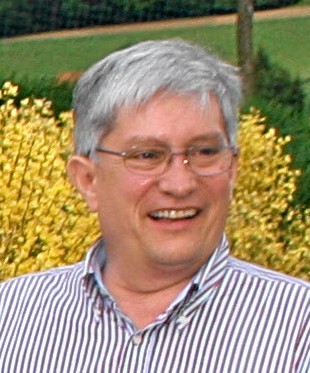 After
reading newsletter 189, Hannes Graf and I had several emails back and forth, he asked how was
the Burgenland Bunch doing in the St. Louis, Missouri area. My response was that I had nothing
to report; if it was alive and well, I had no knowledge of that. Well, Hannes challenged me,
and asked what could I do to get it off of life support. As a result, we found that
approximately 70 members were located in the area where I live. An email was sent indicating
that we were attempting to get the members together. Of course, a problem with email addresses
is, that many are outdated and they came back undeliverable. However, about 20 members did
respond favorably, and some are still trickling in. After
reading newsletter 189, Hannes Graf and I had several emails back and forth, he asked how was
the Burgenland Bunch doing in the St. Louis, Missouri area. My response was that I had nothing
to report; if it was alive and well, I had no knowledge of that. Well, Hannes challenged me,
and asked what could I do to get it off of life support. As a result, we found that
approximately 70 members were located in the area where I live. An email was sent indicating
that we were attempting to get the members together. Of course, a problem with email addresses
is, that many are outdated and they came back undeliverable. However, about 20 members did
respond favorably, and some are still trickling in.
First meeting of the Burgenland Bunch of Missouri
So let's plan for the 10th of September. 7:00PM. My wife and I live at 15908 Wetherburn Road,
Chesterfield MO. 63017. We are just off Clarkson Road between Clayton Road and Kehrs Mill
Roads. Our street Wetherburn is on the east side of Clarkson Rd, 3 miles south of Chesterfield
Mall. We are the second home from the end of the street on the right hand side (south). Our
mail box is the only one that is white with flowers on it.
Be prepared to discuss what you would like to see our group do. If everyone shows up, we will
have a total of 12 people. We should plan on defining a meeting location, day of the month and
the months that we will get together, and what our "mission" is.
Please let me know if you will be attending. I have been waiting for a special occasion to
open a very large bottle of "Burgermeister wine" given to me by the Bürgermeister of Mödling,
Austria. This is a suitable special occasion.
Ronald E. Markland P.E.
15908 Wetherburn Road
Chesterfield, MO 63017
remron1(a)sbcglobal.net |
| 4) BB PICNIC IN ST. PAUL, MN (By Charlie Deutsch)
Thanks to all the folks who attended our picnic on Sunday, August 9. We gathered at the
Germanic-American Institute in St. Paul, MN. The weather was steamy, but the food and
fellowship made for a rewarding afternoon. We were given the opportunity to sample three
different late harvest Burgenland wines. Several people joined us for the first time, and a
few people were pleasantly surprised to find relatives and near relatives. We had a short
discussion on the Burgenland Honored and Remembered list; several people are compiling their
own lists which we will assemble for submission. Dale Knebel volunteered to make the South
Dakota list, and Charlie Deutsch will work on the Calvary Cemetery (St. Paul, MN) list.
Charlie Deutsch has completed a digitization project of the Saint Bernard's Church Baptism,
Death, Marriage, and School records covering the years 1890 through 1930. Saint Bernard's was
forced to close the grade school in 2009, ending 118 years of existence. The Church and High
School will continue to operate.
If you need record lookups, contact Charlie at
charlie.deutsch(a)gmail.com.
Saint Bernard's was the home parish of thousands of Burgenland and Bohemian-German immigrants.
Next meeting
The next meeting has been scheduled for Sunday, October 11, 2009, again at the
Germanic-American Institute, 301 Summit Avenue in St. Paul, 1 PM to 4:30 PM.
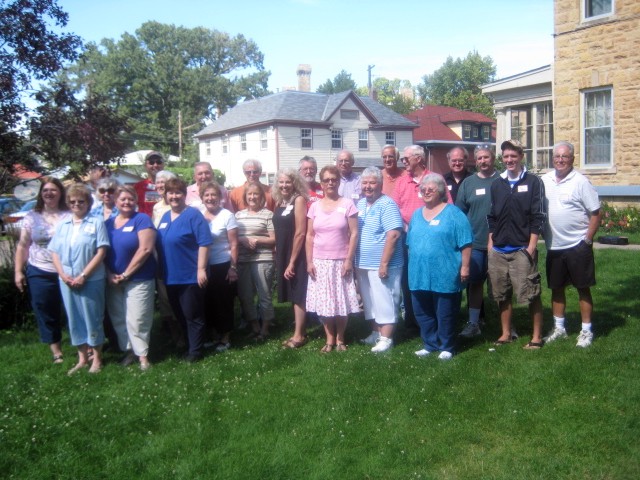 Here
is the list of attendees: Here
is the list of attendees:
Charlie & Vicki Deutsch, Dale Knebel, Ellie Nicklawske, Reynald Dittrich, Arden & Sue
Erickson, Judy Gardner, Dean Wagner, John & Mary Jane Pitzl, Kit & Marilyn Natz, Tom, Jim &
Tony Meyers, Rick & Jayne Tischler, Al Tischler, Mary Kiecker, Judy Vermeulen, Carol
Lauren-Schmidt, Dave & Lois Kelley, Jeff Neuberger, Jill Johnson, Tom Lackner, Lorraine
Lauren, Jeanette MacDonald, Shirley Kresko, Chuck & Joelle Knopf, Rosemary Ruffenach, Tom Behm |
| Additional notes by Jill Johnson
After group announcements, Jill Johnson, a Pamhagen TSCHIDA descendant, asked if there were
any other Pamhagen people in attendance. Two women, Sue (Thompson) Erickson and her cousin,
Judy Gardner, responded, "yes." After reviewing each other's research notes, they determined
they were in fact all related to each other. Their great-great grandfathers were brothers. |
|
5) AN ANNIVERSARY WORTH REMEMBERING AND CELEBRATING (by Emmerich Koller)
Twenty years ago, on a nice sunny August day at the border between Austria and Hungary, a gate
was opened for a few hours during a cross-border picnic on the road between St.
Margarethen/Margitbánya in Burgenland and Sopronköhida in Hungary. The picnic was held at
Sopronpuszta; the event itself entered world history as the Pan-European Picnic of August 19,
1989. When visiting East German tourists in Hungary got wind of this event, they hurried there
with their Trabis and Wartburgs, abandoned them at the roadside and fled through that open
gate to Austria. Although the border guards still had orders to shoot, to their and their
local commander's everlasting credit, they ignored the order and the exodus of about 600 East
Germans ended without anyone getting hurt. Less than a month later, on September 11, the
border between Hungary and Austria was opened for good. This bold act on the part of the
Hungarian government at the time initiated a process that eventually culminated in the
complete removal of the Iron Curtain from the Baltic to the Adriatic Seas, the fall of the
Berlin Wall, and the end of the Cold War.
In the two decades since then, there have been many positive political and economic
developments between Hungary, Austria and the rest of Europe. And, although my focus on this
20th anniversary is on the good things that have already happened and on what the future may
hold, let me begin with a brief recap of a terrible past so that we may never forget.
I was an eyewitness to and victim of the misery that Hungary's socialist government
perpetrated on its citizens. Life was especially hard for those who lived in villages that
were too close to the border. Pernau/Pornóapáti in the lower Pinka valley was one such village
where as a boy I watched the Iron Curtain go up in 1948. I sensed the distress it caused among
the adults and I experienced the sudden separation from our friends, relatives and neighbors
on the other side in Gaas, Eberau, Kulm, Bildein, Edlitz, Winten, Höll, Deutsch-Schützen and
Eisenberg. The security inside and outside my village was very tight, the isolation almost
total. There was a time in the early 1950's when I feared that even a longing look to the
West, past the mines and barbed wire, would be detected and punished by the grim border
guards. My apprehension was justified. One day in 1953, my father and mother were arrested,
detained and interrogated for merely exchanging greetings with my uncle, Father George
Schrammel, on the other side. The ultimatum that my father was given by the secret police
eventually led to his decision to escape during the revolution in 1956. There were many who
couldn't tolerate being fenced in like cattle and so they tried to leave even before the
revolution. Some made it, some did not. One dark night in 1952, our neighbor made an attempt
to escape but he stepped on a mine that ended not only his dream of freedom but also his life.
After 1989, previously unthinkable developments greatly improved the lives of all people in
former East Block countries, including Hungary. But the most significant improvement for the
villages in the lower Pinka valley happened on December 21, 2007, when the border was finally
opened to unrestricted local traffic. Before that, if they wished to visit each other,
neighbors who lived only two kilometers from their destination had to travel hours to cross at
a few designated crossings. In 2005, when I visited the site of the former Cistercian
monastery of Pernau, located right by the border, an unguarded ramp and an old road, overgrown
with tall weeds, stopped me from driving over to Deutsch-Schützen less than a kilometer from
there. For a long while after that, a disturbing thought bothered me. Now that neighbors had a
chance to rebuild a unity that had existed for centuries, they seemed unable or unwilling to
do so.
A fundamentally different situation presented itself last year, during my most recent visit to
my home village. The roads to Bildein and Deutsch-Schützen were now paved, open, and
unguarded. When I drove to Bildein to visit relatives and boyhood friends, no one stopped me;
no one cared that I was crossing from Hungary to Austria. The joy that I felt was the perfect
antithesis to the fear I felt 52 years before that when my family and I took that same road to
leave our ancestral home forever.
In the last two years, the villages in the lower Pinka valley have been busy establishing new
connections to each other. In a recent e-mail, my godson Gottfried Eberhardt, a prominent
citizen of the village of Bildein, wrote the following: "Much has changed since the opening of
the border. On the negative side I would list the increased traffic through Bildein and two
recent robberies. On the positive side, I can list many more examples. A Hungarian artist
opened a shop in our village and he does very good work. Kirchtage, i.e., feasts of the patron
saints are celebrated together. Fire departments from both sides have joint exercises. Young
Hungarian soccer players now play for the Eberau Soccer Club. On July 26, a cross-border party
was organized at which the Bürgermeister of Pernau displayed his Trabi and the women cooked
Hungarian specialties. Our very successful "Picture On" rock festival on August 8 was also a
cross-border affair. This September, a new private school is opening in Eberau in which
German, English and Hungarian will be taught. Of the 72 students, half are from prominent
Hungarian families. Often we go on bike tours to a Buschenschank or Gasthaus on the other
side. The hunters of my village often go to the firing range in Hungary. Today I was shooting
at our own firing range where by chance I met my relative from Großdorf/Keresztes. And by the
way, when the mushrooms grow in our forest, one can find scores of Hungarians looking for
mushrooms."
Gottfried's report may serve as an example of what is happening all along the border. Similar
connections in other neighboring villages are recreating once again the social and economic
fabric that used to make the Pinka valley a harmonious community. I remember a time shortly
after the war when my uncle Lajos Takács from Deutsch-Schützen crossed the border every day to
be a shoemaker's apprentice to my father; family ties were strengthened by asking Austrian
relatives to be godparents or confirmation sponsors; and like my grandfather Schrammel, who
married a girl from Deutsch-Schützen, the border didn't stop young people looking for partners
on the other side. Just about every family in Pernau had relatives in neighboring Austrian
villages. As this natural interaction among neighbors is returning again, the lower Pinka
valley is becoming once again what it was meant to be: a place where people can live in
freedom and harmony, without the interference of national politics and pernicious ideologies. |
|
6) ST. MARGARETHEN IN AUGUST 1989 (by Margaret Kaiser)
A Hungarian student in a BBC News School Report recalled the events of 20 years ago when on
August 19, 1889 a special event was held jointly in St. Margarethen, a Burgenland border
village, and Sopronpuzta in Hungary. The border was opened for a couple of hours for Austrians
to cross the border in order to attend the event. This special border opening received
publicity. As a result, Eastern Germans attended and took this opportunity to cross into
Austria abandoning their Trabant and Wartburg cars along the Hungarian roadside.
http://news.bbc.co.uk/2/hi/school_report/8205010.stm |
|
7) A BURGENLAND VISIT (by Pamela Zogman)
Hello, my name is Pamela Zogman. I am a new member to the Burgenland Bunch. My grandfather
settled in Chicago in 1921 after immigrating from Welgersdorf, Austria.
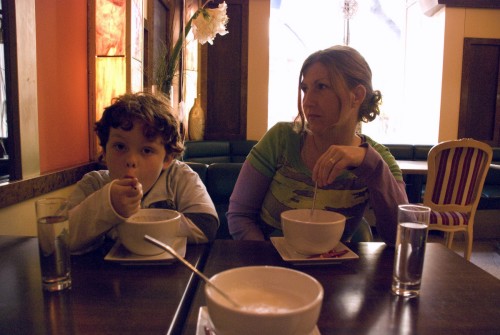 In March,
I had the most wonderful trip to Burgenland. Before departing the states, a good German friend
of mine advised me that I would not be able to go to the church in Welgersdorf for a birth
record; in small towns, they commonly share a priest. My friend advised me to go to
Großpetersdorf. Luckily for me I had asked her to write a letter in German describing what I
was looking for. When I arrived in Großpetersdorf, the woman at the local church only spoke a
little English and the letter proved helpful. She sent me on to another town (I can't recall
the name). In this town[,] no one was at the church. I stood around wondering what to do. Then
a nice couple came out from their home and offered help. They then called a woman employed by
the church by the name of Amy Wagner. Amy advised the couple to send us over to her and she
would take us to the records. We then followed Amy to another town (I think it was
Hannersdorf). She opened a glorious cabinet filled with books holding records. What a sight to
see all these old fabulous books with people's histories inside! We took a photo of my
grandfather's record. Amy then went out of her way to guide us to Welgersdorf. She wanted to
make sure we found it. In March,
I had the most wonderful trip to Burgenland. Before departing the states, a good German friend
of mine advised me that I would not be able to go to the church in Welgersdorf for a birth
record; in small towns, they commonly share a priest. My friend advised me to go to
Großpetersdorf. Luckily for me I had asked her to write a letter in German describing what I
was looking for. When I arrived in Großpetersdorf, the woman at the local church only spoke a
little English and the letter proved helpful. She sent me on to another town (I can't recall
the name). In this town[,] no one was at the church. I stood around wondering what to do. Then
a nice couple came out from their home and offered help. They then called a woman employed by
the church by the name of Amy Wagner. Amy advised the couple to send us over to her and she
would take us to the records. We then followed Amy to another town (I think it was
Hannersdorf). She opened a glorious cabinet filled with books holding records. What a sight to
see all these old fabulous books with people's histories inside! We took a photo of my
grandfather's record. Amy then went out of her way to guide us to Welgersdorf. She wanted to
make sure we found it.
In Welgersdorf, I was standing in front of a house that, according to my grandfather's birth
record, was the home of his birth. It turns out the house numbers have changed since 1904. If
I hadn't been standing in front of the wrong house at that moment in time I would not have had
the fortuitous meeting with a local gentleman by the name of Jürgen. Jürgen took me under his
wing and thought of how he could best help me. He decided to take me to an elder in the
community.
He advised me this 77 year old man, whose name was Herbert, was very ill. He wasn't sure if
Herbert would be able to help, but we could try. I followed Jürgen to this man's home. As
Jürgen was about to walk up to Herbert I remembered that I had brought a picture with me. In
the picture was my grandfather with two women and I had no idea who the women where. Jürgen
brought the picture up to Herbert and he exclaimed, "That is my mother." Herbert's biological
mother died when he was baby. His father remarried my great Aunt (one of the woman in the
picture) who raised him from the age of one. Jürgen had no way of knowing this man would be
related to me because he had a different last name than my family. Herbert had company but
asked us to come back at 5 p.m. it was around noon.
Jürgen then took care of us for the whole day. He fed my family and showed us around. When we
went back to Herbert's home he produced a photo album of my family. Now, remember I had no
idea Herbert existed (he is my deceased father's cousin by marriage). The first picture in the
album was of my grandfather and my aunt that lives in Chicago. Herbert then showed us pictures
of my whole family from Welgersdorf that I never knew about: my grandfather's brothers and
sisters. My grandfather died when I was three and no one had ever asked him any information on
his heritage. Needless to say, we had a magical experience. I left Herbert and Jürgen feeling
transformed.
I was so grateful for all the help they gave in putting together my heritage. It turned out
that Herbert died a month after my visit. He was the last relative in Welgersdorf from my
immediate family tree. If I had not gone at that exact time I would have never met Herbert and
been connected to my roots.
If anyone would like to taste a wonderful product that comes from Burgenland, Jürgen makes
delicious Mead: visit www.velmet.at. Mead
is wine made from honey. All of the honey is locally sourced.
Feel free to contact me with any questions
pamzog(a)earthlink.net. I also
had short visits to Vienna and Graz if you need any information.
Newsletter continues as number 190A.
|
|
THE BURGENLAND BUNCH NEWS - No. 190A
DEDICATED TO AUSTRIAN-HUNGARIAN BURGENLAND FAMILY HISTORY
August 31, 2009
(c) 2009 - The Burgenland Bunch - all rights reserved
The second section of this 3-section newsletter includes:
1) LET'S GO WEST - A TRIP REPORT
2) THE CASTLE RUIN OF LANDSEE
3) RAILROAD QUESTION
4) BURGENLAND EMIGRANT OBITUARIES (courtesy of Bob Strauch) |
|
1) LET'S GO WEST - A TRIP REPORT
I am sitting at my desk table hearing in the background the "New World Symphony" from Antonin
Dworak and remember what happened two months ago. Yes, I was there: it was no dream, it was
reality. When I close my eyes, I remember every second, from the first step in New York to the
last one in Indianapolis.
At first, I want to thank everybody who make this trip possible.
My wife Elfie, who tells me in April: "For what would You wait? Do it! Think about, how sad
You was, when You don't do it at the time when Gerry was alive!"
My hosts and sponsors, who makes it possible, without killing my financials totally: Frank &
Elsie Paukowits, Tom Steichen, Anna & Rudy Kresh, Martin & Amy Schreyer, Joanne & Mike Hayden
and Mike Schreyer.
Thank You; without You this would never have been.
24th of June 2009
 From the moment when I
have to check in, a different world begins. I was never on a flight, so also I was never in
the USA or outside of Europe. All was new for me, and I had not slept the night before. At
11.05 the flight started from Vienna and ended at 14.00 (+6 hours) in NY-JFK. When we got out
of the plane, we arrived to the customs area, where nearly 1000 people were waiting. I was
thinking , "Oh my god, it will take 3 hours to go out of the airport; I hope Frank will wait
for me." It took really 2,5 hours to come out and meet Frank and Elsie Paukowits who were
waiting for "Santa Claus". I was very tired and so we have no sightseeing this day. Also when
I start in Vienna, there has been about 19° C low humidity, but in Queens it had about 38° C
and a full humidity. So I had troubles to breathe and I immediately got a cold from the
differences between real and air-conditioned temperature. I also was not able to sleep the
first night for more than 2-3 hours. From the moment when I
have to check in, a different world begins. I was never on a flight, so also I was never in
the USA or outside of Europe. All was new for me, and I had not slept the night before. At
11.05 the flight started from Vienna and ended at 14.00 (+6 hours) in NY-JFK. When we got out
of the plane, we arrived to the customs area, where nearly 1000 people were waiting. I was
thinking , "Oh my god, it will take 3 hours to go out of the airport; I hope Frank will wait
for me." It took really 2,5 hours to come out and meet Frank and Elsie Paukowits who were
waiting for "Santa Claus". I was very tired and so we have no sightseeing this day. Also when
I start in Vienna, there has been about 19° C low humidity, but in Queens it had about 38° C
and a full humidity. So I had troubles to breathe and I immediately got a cold from the
differences between real and air-conditioned temperature. I also was not able to sleep the
first night for more than 2-3 hours.
25th of June
 The first sightseeing
trip to lower Manhattan, after a curious breakfast. Frank, Elsie and I go by LIRR and subway
to the southern-most point. When I came out to the streets, I was so overwhelmed about the
buildings and so many people around. Also I was the only person in Manhattan who had a jacket
on. This made everybody know that I was a tourist. I know that I will make a similar trip as
my Lehner and Schreyer relatives made it 1904. They started in Ellis Island and ended up in
South Bend. The first sightseeing
trip to lower Manhattan, after a curious breakfast. Frank, Elsie and I go by LIRR and subway
to the southern-most point. When I came out to the streets, I was so overwhelmed about the
buildings and so many people around. Also I was the only person in Manhattan who had a jacket
on. This made everybody know that I was a tourist. I know that I will make a similar trip as
my Lehner and Schreyer relatives made it 1904. They started in Ellis Island and ended up in
South Bend.
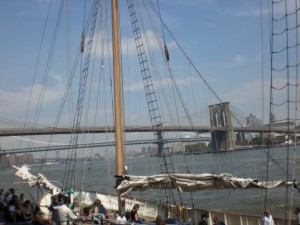 But
after looking to the Ellis-Island and Liberty-Island over the water, I decide to don't want to
go there, because it was too much for me. We had to wait some hours for getting tickets
because it was the end of school and there were many people. So I will see it when I come
again and there is a reason to come back. After a walk into the streets around Ground Zero, we
went to the East River, where we had a longer rest. My favorite points are water (sea, lakes,
river) and bridges, so it was a nice point under the Brooklyn Bridge. At the evening, we drove
back, to see Manhattan at night; it was really amazing, with all the lights on the streets and
bridges. But
after looking to the Ellis-Island and Liberty-Island over the water, I decide to don't want to
go there, because it was too much for me. We had to wait some hours for getting tickets
because it was the end of school and there were many people. So I will see it when I come
again and there is a reason to come back. After a walk into the streets around Ground Zero, we
went to the East River, where we had a longer rest. My favorite points are water (sea, lakes,
river) and bridges, so it was a nice point under the Brooklyn Bridge. At the evening, we drove
back, to see Manhattan at night; it was really amazing, with all the lights on the streets and
bridges.
26th of June
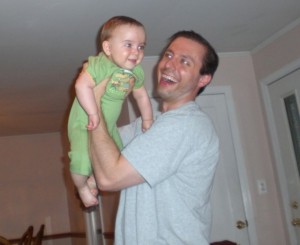 I
cannot sleep well again, maybe for 4 hours. This day we had breakfast at "Dunkin' Donuts"; I
always wondered about that, because I understand it as "drunken donuts," so I was not sure
about the illumination scale after the breakfast. But there I meet some of the friends of
Frank and Elsie, nice mix of people. We went to the NY Transportation Museum in Brooklyn; it
was very interesting to me, because I am a fan of all transport systems. In the afternoon we
had a trip to Long Beach and at the evening. I met their family, and grandson Kenny. (see
NL-182) I
cannot sleep well again, maybe for 4 hours. This day we had breakfast at "Dunkin' Donuts"; I
always wondered about that, because I understand it as "drunken donuts," so I was not sure
about the illumination scale after the breakfast. But there I meet some of the friends of
Frank and Elsie, nice mix of people. We went to the NY Transportation Museum in Brooklyn; it
was very interesting to me, because I am a fan of all transport systems. In the afternoon we
had a trip to Long Beach and at the evening. I met their family, and grandson Kenny. (see
NL-182)
27th of June
The ride begins. From this moment I was a passenger and looked out of the car windows for the
next 2000 miles. We drove to Allenton, but I think all other New Yorkers do it also. So we
need a little longer as we would. From the flat Big Apple over the Hudson seeing the rocks of
New Jersey and the beginning hilly countries to Lehigh Valley, the area was more and more
looking like the southern Burgenland. I think, many people settled there because the landscape
looks like the "Heimat". On the way, I was very interested about how many cemeteries Frank
knew. At the meeting, it was nice to see some of the Staff personally, I had met only Frank
Paukowits 2008 and Tom Glatz 2006 before in Burgenland, and also Gerry & Molly Berghold in
2001. The meeting story from Tom Steichen was at the last NL.
28th of June
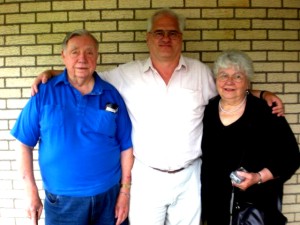 Attending
at the Stiftungsfest of the Coplay Sängerbund, I meet many people, whose names I now forget;
sorry. I had so many meetings, I never remember who told me what. I made some pics of the
Coplay cemetery with many Burgenländer names on the gravestones. Also, I attended the concert
of the best Hianzn choir I ever heard in my life, with the famous bandleader Bobby Strauch. At
Emma's dessert-kitchen, we had a good ending of the meeting days and I was taken to my next
hosts, Rudy and Anna Kresh. Attending
at the Stiftungsfest of the Coplay Sängerbund, I meet many people, whose names I now forget;
sorry. I had so many meetings, I never remember who told me what. I made some pics of the
Coplay cemetery with many Burgenländer names on the gravestones. Also, I attended the concert
of the best Hianzn choir I ever heard in my life, with the famous bandleader Bobby Strauch. At
Emma's dessert-kitchen, we had a good ending of the meeting days and I was taken to my next
hosts, Rudy and Anna Kresh.
29th of June
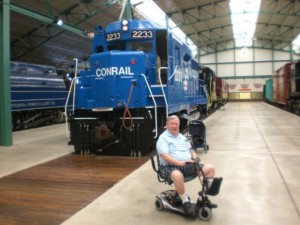 This
day was the hardest, I think, for all of us three. We started to look of all the remembering
places, I saw their first apartment, where the first child was born, some schools, colleges,
where also Gerry Berghold has been, and Frank Teklits, if I'm correct. Then we drove to
Amishland, looking for the horse-wagons and farm workers like Burgenland 150 years ago. The
next stop was at the Pennsylvanian Railroad Museum at Strasburg, nearby Lancaster. There we
look around for some hours before starting to the next point. We cross the Susquehanna to York
and Gettysburg. After attending the show at the Museum we drove around the historic area and I
made a walk at the "Little Round Top", to overview the scenery. This day ended at the Kresh
Lane in Butler after nearly 19 hours! We were really nearly dead! This
day was the hardest, I think, for all of us three. We started to look of all the remembering
places, I saw their first apartment, where the first child was born, some schools, colleges,
where also Gerry Berghold has been, and Frank Teklits, if I'm correct. Then we drove to
Amishland, looking for the horse-wagons and farm workers like Burgenland 150 years ago. The
next stop was at the Pennsylvanian Railroad Museum at Strasburg, nearby Lancaster. There we
look around for some hours before starting to the next point. We cross the Susquehanna to York
and Gettysburg. After attending the show at the Museum we drove around the historic area and I
made a walk at the "Little Round Top", to overview the scenery. This day ended at the Kresh
Lane in Butler after nearly 19 hours! We were really nearly dead!
30th of June
 From this day on, I was
acclimatized; I could breathe better and I slept well for the first time. Also, it was the
not-air-conditioned border of America. We drove around the landscape and to Pittsburgh, where
Anna shows me the Austrian Room at the Cathedral of Learning. We took Anna's grandson with us
and he liked to do everything with the adults. From this day on, I was
acclimatized; I could breathe better and I slept well for the first time. Also, it was the
not-air-conditioned border of America. We drove around the landscape and to Pittsburgh, where
Anna shows me the Austrian Room at the Cathedral of Learning. We took Anna's grandson with us
and he liked to do everything with the adults.
1st of July
From Burgenland-Bunch to family.
After driving me to East Liverpool, OH, this was the moment to say goodbye. It was very
hard to let them go away without any tears. Grand-Cousin Martin Schreyer and wife Amy was now
my host for this day and Cousin Mike Schreyer also arrived at the evening. I was resting the
whole afternoon. At evening, we had a dinner at the Ohio River.
2nd of July
The next big trip, from East Liverpool to Zionsville, IN. We need the whole day, with joking
as we every time do. I ever was wondering about the big birds flying over the Free-, Park- and
Highways. Mike tell me about the "roadkill" and the "health police". So we spent the evening
at the house of Joanne and Mike Hayden, where I stayed for some days. We had enough to talk
and eat and drink and at night a nice visitor: Rocky Raccoon. I never saw so many wild animals
near people, never saw free humming-birds, cardinals and many other birds like vultures.
3rd of July
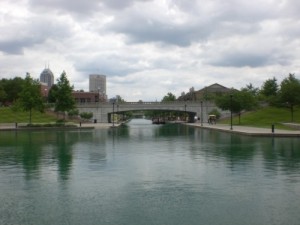 We
meet at Indianapolis at the area, where Emily Hayden was living, before she went to Harvard as
teacher. It is beside the medical centers and I think it was a canal or a creek before, but in
between it's nice to walk around. I did not know it, but in the days when I was in NY,
something happened what changed very much. Heidi, the 22 years old daughter of Gary Schreyer
died by diabetes complications. So that half of the family was very sad and didn't attend some
planned meetings. I understood the situation and at the afternoon we rode to Logansport for a
"say good bye" ceremony. We
meet at Indianapolis at the area, where Emily Hayden was living, before she went to Harvard as
teacher. It is beside the medical centers and I think it was a canal or a creek before, but in
between it's nice to walk around. I did not know it, but in the days when I was in NY,
something happened what changed very much. Heidi, the 22 years old daughter of Gary Schreyer
died by diabetes complications. So that half of the family was very sad and didn't attend some
planned meetings. I understood the situation and at the afternoon we rode to Logansport for a
"say good bye" ceremony.
4th of July
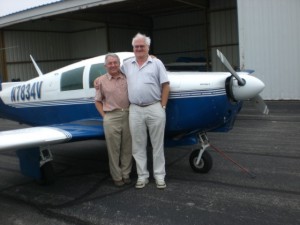 At the last evening,
I was very daring to accept a flight with cousin Mike Hayden in his Mooney airplane. But this
I will never forget, a flight around the Indianapolis area and looking down, seeing all the
farmland and buildings. Mike is a real good pilot since 38 years. The second highlight should
be the 4th of July party, but it rains hard, so the Indianapolis downtown fireworks was
cancelled. Mike has an apartment on the 19th floor with full sight of downtown. But I met some
new family members and children there. At the last evening,
I was very daring to accept a flight with cousin Mike Hayden in his Mooney airplane. But this
I will never forget, a flight around the Indianapolis area and looking down, seeing all the
farmland and buildings. Mike is a real good pilot since 38 years. The second highlight should
be the 4th of July party, but it rains hard, so the Indianapolis downtown fireworks was
cancelled. Mike has an apartment on the 19th floor with full sight of downtown. But I met some
new family members and children there.
5th of July
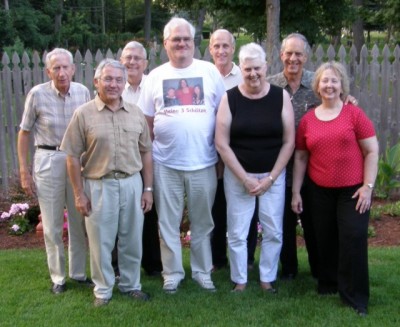 All
together, we started in the morning for a trip to South Bend, where the Lehner and Schreyer
families had settled. They show me the house where the grandparents are living, the train
crossing where Andrew Schreyer in 1927 found his end (NL-130), the houses where the parents
are living, schools, the Notre Dame University, the cemeteries, the area where the Lehner-farm
was located (today, it is the Lehner-court of Granger with Lehner-street) and so on. A Freeway
crosses the farmland and most of the area is housing developments. At last we had a gathering
of all relatives at the home of John & Judy Lehner beside the Notre Dame University area. Paul
M. Lehner, III invited also some BB-Members so we had a little "BB-Indiana-picnic". At the
evening we drove to the apartment of Joanne and Mike Hayden in Culver at Lake Maxinkuckee to
stay over night. All
together, we started in the morning for a trip to South Bend, where the Lehner and Schreyer
families had settled. They show me the house where the grandparents are living, the train
crossing where Andrew Schreyer in 1927 found his end (NL-130), the houses where the parents
are living, schools, the Notre Dame University, the cemeteries, the area where the Lehner-farm
was located (today, it is the Lehner-court of Granger with Lehner-street) and so on. A Freeway
crosses the farmland and most of the area is housing developments. At last we had a gathering
of all relatives at the home of John & Judy Lehner beside the Notre Dame University area. Paul
M. Lehner, III invited also some BB-Members so we had a little "BB-Indiana-picnic". At the
evening we drove to the apartment of Joanne and Mike Hayden in Culver at Lake Maxinkuckee to
stay over night.
6th of July
At noon, Emmerich Koller came to Culver and we had a meeting together with Mike. At afternoon,
we drove back to Zionsville, but on the way we looked to a lake, where Joanne and Mike had
their childhood vacations.
7th of July
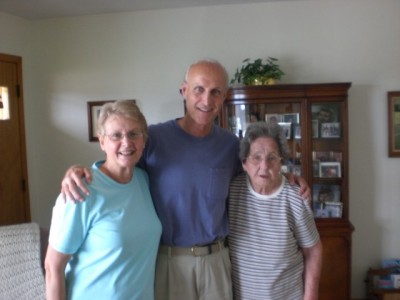 We
changed our program, because at 5th of July, Mike talks with Evelyn Lehner about the farm and
some rememberings. So we drove again to South Bend to meet her, because she is 98 years old.
We had a good day at her home, beside the old farmhouse which still exists. She shows me a
picture of an unknown woman, but it was my grandmother! After the meeting, we had a short trip
to the Michigan lake for a little evening walk. We
changed our program, because at 5th of July, Mike talks with Evelyn Lehner about the farm and
some rememberings. So we drove again to South Bend to meet her, because she is 98 years old.
We had a good day at her home, beside the old farmhouse which still exists. She shows me a
picture of an unknown woman, but it was my grandmother! After the meeting, we had a short trip
to the Michigan lake for a little evening walk.
8th of July
Flying home and landing at 9th in the morning, where Elfie awaits me at the airport with a
tall sunflower.
----------
All together, I shot 1100 pics, met many people, including about 70 BB-members, and see very
much news. I got a big Jetlag, which needed about 4 weeks before I came back to my reality. My
days have felt like the night. But it was good to do this trip and I try to do it again.
Conclusion:
Before the trip, all my hosts asked me about what I want to see or meet and I told them: I
want to see how you are living, where did you grow up; family, friends and normally how things
are.
And this was exactly what I got from all.
Thank You. |
|
2) THE CASTLE RUIN OF LANDSEE
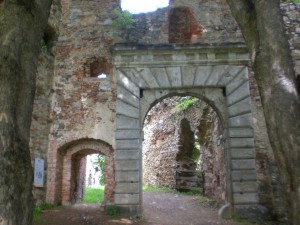 The
Göttweig monastery's traditional records of the year 1158 mention a "Gotscalcus de
Landeshere." The first castle was erected probably somewhat earlier to protect an important
road. The Landsees were ministers of the Earls of Pitten and presumably kinsman of the
Stubenberger family from Styria. The castle became possession of the Hungarian Crown already
in 1222. It was the western outpost of the county of Lutzmannsburg and part of the line of
castles which was to protect the western border of Hungary. King Béla IV passed it to his
cupbearer Conrad who, however, changed fronts and became a follower of the Bohemian king
Przemysl Ottokar II. Therefore, in 1263, Landsee was handed over to his Steward and Gespan (a
medieval chieftain in the west and south Slavic region) of Ödenburg, Laurentius Aba, whose
successors were followers of the earls of Güssing. And so Landsee was one of the castles that
were conquered by Duke Albrecht in course of the feud of Güssing in 1289. The
Göttweig monastery's traditional records of the year 1158 mention a "Gotscalcus de
Landeshere." The first castle was erected probably somewhat earlier to protect an important
road. The Landsees were ministers of the Earls of Pitten and presumably kinsman of the
Stubenberger family from Styria. The castle became possession of the Hungarian Crown already
in 1222. It was the western outpost of the county of Lutzmannsburg and part of the line of
castles which was to protect the western border of Hungary. King Béla IV passed it to his
cupbearer Conrad who, however, changed fronts and became a follower of the Bohemian king
Przemysl Ottokar II. Therefore, in 1263, Landsee was handed over to his Steward and Gespan (a
medieval chieftain in the west and south Slavic region) of Ödenburg, Laurentius Aba, whose
successors were followers of the earls of Güssing. And so Landsee was one of the castles that
were conquered by Duke Albrecht in course of the feud of Güssing in 1289.
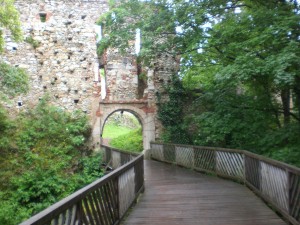 But following the
peace of Hainburg the command over the castle was restored to the king of Hungary. Then the
Athinais of the family of the Aba were in possession of Landsee but at the end of the 14th
century it passed to the Earls of Mattersdorf-Forchtenstein. Wilhelm of Forchtenstein, the
last of his family, pawned his properties to the Habsburger Albrecht VI, who bought Landsee in
1447 and passed it on to his brother, Emperor Friedrich III. In 1459, the dominion fell into
the hands of the Hungarian king Matthias Corvinus. In 1482 he endowed with the dominion Ulrich
von Grafeneck, who, however, is recorded as owner already for the year 1475. It was him who
ordered the late Gothic styled upgrading of the stronghold. In 1506 Ulrich von Weisspriach,
who also was Lord of Kobersdorf, became fief-holder in Landsee. His possessions were located
around Ödenburg (Sopron) which constantly led to conflicts. In the following "Landsee-feud,"
his widow hired several groups of mercenaries, including the bandit leader Franz Magutsch, to
harass the city. Finally the bandits were caught and Gertrud von Weisspriach died in jail in
1523. But following the
peace of Hainburg the command over the castle was restored to the king of Hungary. Then the
Athinais of the family of the Aba were in possession of Landsee but at the end of the 14th
century it passed to the Earls of Mattersdorf-Forchtenstein. Wilhelm of Forchtenstein, the
last of his family, pawned his properties to the Habsburger Albrecht VI, who bought Landsee in
1447 and passed it on to his brother, Emperor Friedrich III. In 1459, the dominion fell into
the hands of the Hungarian king Matthias Corvinus. In 1482 he endowed with the dominion Ulrich
von Grafeneck, who, however, is recorded as owner already for the year 1475. It was him who
ordered the late Gothic styled upgrading of the stronghold. In 1506 Ulrich von Weisspriach,
who also was Lord of Kobersdorf, became fief-holder in Landsee. His possessions were located
around Ödenburg (Sopron) which constantly led to conflicts. In the following "Landsee-feud,"
his widow hired several groups of mercenaries, including the bandit leader Franz Magutsch, to
harass the city. Finally the bandits were caught and Gertrud von Weisspriach died in jail in
1523.
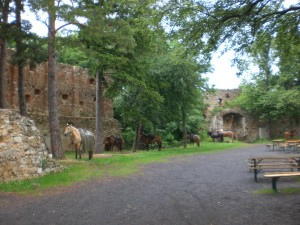 In 1548 her son Hans
handed Landsee to his brother-in-law, the imperial councilor and Gespan Erasmus Teufel. But
Teufel was caught and executed in Istanbul by the Turkish and the archbishop of Gran
(Esztergom), Nikolaus Oláh, bought the dominion of Landsee. In 1561 he handed it over to his
nephew Nikolaus Császár, whose son-in-law started the extension of the castle to a mighty
fortress shortly before 1600. When his daughter Ursula married Nikolaus Esterházy in 1612,
Landsee became the possession of the family, still owning it today. In 1548 her son Hans
handed Landsee to his brother-in-law, the imperial councilor and Gespan Erasmus Teufel. But
Teufel was caught and executed in Istanbul by the Turkish and the archbishop of Gran
(Esztergom), Nikolaus Oláh, bought the dominion of Landsee. In 1561 he handed it over to his
nephew Nikolaus Császár, whose son-in-law started the extension of the castle to a mighty
fortress shortly before 1600. When his daughter Ursula married Nikolaus Esterházy in 1612,
Landsee became the possession of the family, still owning it today.
The castle was further extended according to the advanced war engineering of the time. During
the wars against the Turkish, it was used as a sanctuary for the people and as an arsenal for
the Esterházy's troops but it had never been seriously besieged. In 1707, some of the
buildings had been severely damaged by a blaze and a gunpowder explosion. After the Turkish
have been driven out of Central Europe through the victories of Prince Eugen, Landsee lost its
military significance. The arms and other military equipment were brought to Forchtenstein. In
1772 and 1790 there was another blaze and the administration of the dominion was moved to
Lackenbach; the complex was abandoned. The surrounding population used its walls as a welcome
stone quarry for building their houses. In 1950 renovation was started by a local
beautification society. The final restoration of the stronghold was accomplished in the course
of an EU project in 1998. Over the past years, theatrics had been organized in the castle's
bailey.
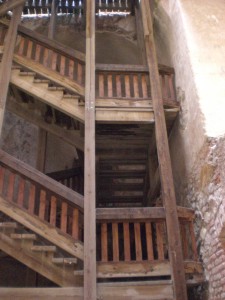 Landsee
is one of the biggest castle ruins in Europe. It lies on a dominant location above the
Stooberbach valley. The actual stronghold is surrounded by four circular fortification walls.
The outer wall is 1700 meters long and fortified by ten small bastions. For the protection of
the first gate, which states the date of 1668, serves a two-story bastion containing a
guardroom. Crossing a bridge lying on piles you reach the second gate above which there is a
broad machicoulis. Originally, a drawbridge used to be in front of it. The gate structure
reaches far into the moat, so that it was possible to take the second defensive wall (a high
earth wall bearing a palisade) under fire from there. This wall was erected around 1600 to
protect the third wall from direct artillery fire. Its gate is protected by a tower and
guardroom as well. The following approximately 20 meters-broad moat is spanned by another
wooden bridge. In front of the next gate was a counterpoise bridge. It was decorated by the
coat of arms of the Weisspriach family. Landsee
is one of the biggest castle ruins in Europe. It lies on a dominant location above the
Stooberbach valley. The actual stronghold is surrounded by four circular fortification walls.
The outer wall is 1700 meters long and fortified by ten small bastions. For the protection of
the first gate, which states the date of 1668, serves a two-story bastion containing a
guardroom. Crossing a bridge lying on piles you reach the second gate above which there is a
broad machicoulis. Originally, a drawbridge used to be in front of it. The gate structure
reaches far into the moat, so that it was possible to take the second defensive wall (a high
earth wall bearing a palisade) under fire from there. This wall was erected around 1600 to
protect the third wall from direct artillery fire. Its gate is protected by a tower and
guardroom as well. The following approximately 20 meters-broad moat is spanned by another
wooden bridge. In front of the next gate was a counterpoise bridge. It was decorated by the
coat of arms of the Weisspriach family.
Now you get into the extensive outer bailey. Its left side is bordered by a mighty frontal
wall, while on the right lie the ruins of several farm buildings and barracks. Their external
walls are provided with embrasures, so that they can be used for defense as well. At the end
of the bailey a stair tower leads to a higher seated inner bailey, where the accommodations
and kitchens were. A beautiful Renaissance gate finally leads to the actual living quarters.
Here, around a triangular bailey, were representative rooms equipped by Pietro Antonio Conti
in the 17th century. Through a Gothic tower heightened in the baroque period you get into the
medieval part of the castle which mainly dates from the late 15th century.
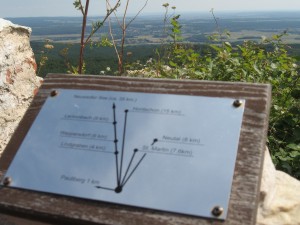 From
a small bailey and via wooden corridors and stairways you could once get into the several
rooms. Still today they show relics of Gothic door and window carpeting, fireplaces and
arches. The Romanic donjon forms the core of the stronghold and was built on the highest point
of the quartzite rock. Later its mainly attacked side in the West was fortified and reached
its today's wall thickness of more than 10 meters. The tower is crowned by a characteristic
wall arch, the relic of a former cupola. From
a small bailey and via wooden corridors and stairways you could once get into the several
rooms. Still today they show relics of Gothic door and window carpeting, fireplaces and
arches. The Romanic donjon forms the core of the stronghold and was built on the highest point
of the quartzite rock. Later its mainly attacked side in the West was fortified and reached
its today's wall thickness of more than 10 meters. The tower is crowned by a characteristic
wall arch, the relic of a former cupola.
Visitation from the beginning of April to the end of October, daily from 9 a.m. to 6 p.m., or
until nightfall.
Guided tours on appointment, for information and registration contact:
Elisabeth Schütz
Hauptstraße 88
A-7341 Landsee
Phone: +43 2618 / 7306
Mobile: + 43 664 / 798 13 16
Homepage in German:
http://www.landseeaktiv.at/burgruine/ruine/ruine.htm |
|
3) RAILROAD QUESTION
Jack Fritz asks:
Hannes:
Since you are a railroad man, I have a question for you.
I have been having email discussions with fellow BB member Mary Kamper Sheridan in Chicago as
to how our ancestors got from Neumarkt imT to the ports of Hamburg, Bremen, & Antwerp. Mary is
my distant double cousin through two sets of ggg..grandparents in Neumarkt. Our grandparents
emigrated to Chicago in 1902, 1903 & 1905.
My great great grandmother Agnes Zartler wrote a letter in 1907 to my grandmother which
mentions my grandmother's cousin coming from NiT to visit them in Kanak, Hungary, near the
present-day border with Serbia and Romania. The letter does not specifically say that he
traveled by train but he was blind and needed to be escorted by soldiers, so my thought is
that he did go by train. My 1897 map of that part of Hungary shows a rail line going right
next to Kanak, so I am thinking that he boarded a train somewhere near NiT and got all the way
to Kanak by rail.
So, the question is, could our grandparents have gotten to the three ports from NiT by rail?
What is your best guess?
Reply:
Good question, because in 1902, not all of the current railroads near Burgenland existed. But
normally, as I know from other members, they ALL went by train to Northern Germany.
From NiT next station was Grosspetersdorf / Nagyszentmihaly, about 3-4 miles. Then to
Szombathely, the greater station, to Györ and Vienna, at last from Vienna to Hamburg or other
ports.
The ride from NiT to Konak also from Szombathely to Belgrad and the line nearby to Konak. |
|
4) BURGENLAND EMIGRANT OBITUARIES (courtesy of Bob Strauch)
Alfred Steiner
(Nov. 12, 1924 - Aug. 25, 2009)
Alfred Steiner, 84, of Whitehall, died Tuesday, August 25, 2009 in St. Lukes Hospital,
Fountain Hill.
Born in Neusiedl bei Güssing, Burgenland, Austria, he was a son of the late Franz and
Magdalena Steiner.
Alfred was the husband of the late Rosa (Trinkl) Steiner.
Alfred worked for many years as a tailor in management positions for various clothing
companies around the Lehigh Valley before his retirement.
Survivors: Daughter, Heidelinde Predix of Chesapeake, Va.; son, Manfred and his wife, Vicki
Steiner, of Walnutport; sisters, Elli Flakus and Wilma Pratter, both of Graz, Austria;
grandchildren, Rachel and Raymond Predix, Melissa Marerro and Nicholas, Kate and Cory Steiner;
great-grandchildren, Tristen and Kingsten Marerro. He was preceded in death by four brothers.
Newsletter continues as number 190B.
|
|
THE BURGENLAND BUNCH NEWS - No. 190B
DEDICATED TO AUSTRIAN-HUNGARIAN BURGENLAND FAMILY HISTORY
August 31, 2009
(c) 2009 - The Burgenland Bunch - all rights reserved
The third section of this 3-section newsletter includes:
1) HOME ON THE FARM IN DANIELSVILLE (from Anna Tanczos Kresh)
2) HUNGARIAN CENSUS OF 1828: (by Bob Unger) |
|
1) HOME ON THE FARM IN DANIELSVILLE (from Anna Tanczos Kresh)
During our attendance at the Stiftungsfest in June, a copy of a Morning Call newspaper article
about the dismantling and moving of a home (see below) was given to me by Frank Tantsits of
Northampton. It prompted this submission about the immigrations of my uncle Louis and father
Ignatz Tanczos.
Louis Tanzos (1879-) and Ignatz Tanczos (1890-1968), father of BB Internet/URL Editor Anna
Tanczos Kresh were sons of ~ John Tanczos (1844-1899) of Kroatisch Tschantschendorf
(Horvatcsencs), Burgenland, parents of John Tanczos were Josef Tanczos and Juliana Keglovics´
~ and Anna Pani (1848-?) of Nr. 62 Tobaibergen, Burgenland, parents of Anna Pani were
Sebastian Pani and Juliana Keglovics. Two great-grandmothers with the same name? This is not
an error. The first Juliana was the dau. of Imre and Katalin Keglovics of Rehgraben. The
second was the dau. of Matyas and Katalin Keglovics, also of Rehgraben.
Louis Tanzos emigrated to Northampton, PA in 1904 and married Mary Keglovits (1885-1971) in
about 1909. Mary Keglovits was the dau. of Alois Keglovits of K.T. Louis and Mary bought a
farm in Danielsville (Delps), PA, where they raised children - Mary (m. Alois Puskaritz),
Louis, and Frank.
Louis' younger brother Ignatz Tanczos (my father) emigrated to Northampton, PA in 1906 and
married Mary Schuch (1893-1964) of Kroatisch Ehrensdorf in 1912. Mary Schuch was the dau. of
Ignatz Schuch of Punitz. As their family grew Ignatz also bought a farm in Danielsville, about
one mile from the farm of his brother Louis. The latter move was in 1921, the same year their
German West Hungary homeland became Burgenland. It is where I was born. Almost all of our
neighbors were Pennsylvania Dutch with very few immigrants in the area.
Other Tanczos siblings were the eldest son John (1871-1950 - m. Anna Miksits 1879-1946 of
Hasendorf); Joseph (1876-?); Francis (1875-?); Theresa (1876-?, m. Francis Jandrisevits 1868-?
of K.T.); Agnes (1882-?); Magdalena (1884-1884); Mary (1886-1954, m. Frank Malits 1880-1958 of
Hasendorf - emigrated to Northampton, PA); Gustav (1889-1889); Eleanor (1893-); two
stepsisters Maria Jandrisevits (1866-) and Anna Jandrisevits Tanczos (1868-, m. Joseph
Klucsarits 1868-) who were the daughters born during Anna Pani's first marriage to Paul
Jandrisevits c. 1834-1869 of K.T.
WHY THE SURNAME CHANGE? Louis' surname was changed from Tanczos to Tanzos (dropping the "c")
somewhere around the time Louis moved from Northampton, PA to the farm in Danielsville, PA,
more commonly known locally as Delps. One explanation given for the name change was to
facilitate receipt of their US Mail. Both his (L. Tanczos) and his brother's (I. Tanczos)
mailing addresses were R.D.#1, Danielsville, PA and my father said that mail was constantly
being misdelivered to the wrong brother, creating several days' delay, so Louis dropped the
"c".
CENSUS ERRORS: The 1910 U.S. Census in Northampton was taken by an enumerator named Llewellyn
Greenawalt (Welsh in origin), apparently one of the local Pennsylvania Dutch residents who was
not at all familiar with Austro-Hungarian names, thus the census forms contained a great
number of misspellings. This was exacerbated by the fact that the woman of the house, probably
speaking Croatian, pronounced the names of the occupants "her way". Uncle Louis and Aunt Mary
(Keglovits) Tanczos (spelled Dansuch on the census) were residing at 1394 Newport Ave. in
Northampton, boarders of John Helevitz (Keglevits?). At the same time my father Ignatz Tanczos
(spelled Stansitch on the census) was living at 1336 Delong's Court, a boarder of Paul
Dragovitch. These spelling errors made genealogical research a bit daunting and necessitated a
line-by-line search. Soundex was of no help and in all my years of visiting Northampton and
attending Northampton High School, I never even heard of DeLong's Court. It is interesting
that my father's language was listed as Croatian in 1910 and German in 1920, probably due to
the Hianzn dialect of the numerous Burgenländers in Northampton.
On Sundays in the summer, our farm in Danielsville was the site of many wonderful gatherings
of Burgenländers, who visited us in large numbers from the "city". I'm not sure if it was for
my mother's great cooking and baking or my father's wine from the ever-present barrel in the
spring located in the cellar of our farmhouse. The old home no longer exists, giving way to
the beautiful stone country home my brother built in its place on Delps Road, long after our
parents' passing. The former dirt road was paved the week Before Rudy and I were married, the
barriers being removed the morning of the wedding, and it now has a name of its own. After the
passing of my brother Edward Tanczos, his home was purchased by a New York City attorney,
whose commute was greatly improved by the building of the Interstate highway. But although the
old homestead is gone, Edward's son Dan retained a good portion of the farm on which he also
built a beautiful stone country home, the site of the reunion of the Tanczos clan when in 2006
we celebrated the 100th anniversary of the emigration of Ignatz and Mary Schuch Tanczos. It
was fitting that the celebration took place in the field where Ignatz (and we, his children)
labored growing the corn and potatoes that provided for the family. We are eternally grateful
for the opportunities that my father, and his brother before him, provided us with their
courageous emigration from their homeland.
The home of Uncle Louis and Aunt Mary also no longer remains in Delps, but its departure is
quite another story . . .
TANZOS HOME MOVES TO TEXAS:
(the following article was published in The Morning Call, Allentown, PA Sunday, June 28, 2009)
1760s home will be resettled in San Antonio
The wooden cabin will be taken apart in Danielsville, put back together in Texas.
DANIELSVILLE -- After nearly 250 years in Danielsville, a 1760s vintage settler's house, among
the earliest in northeastern Pennsylvania, is getting ready for a nearly 2,000-mile trip to be
reassembled on a bow hunting ranch outside of San Antonio.
A crew, led by Rich Williams of Williams Woodworking of Danielsville, has been tagging and
disassembling the modified log structure that had been unoccupied since 1971. The roof had
leaked and the supporting wood rotted to an unsafe condition.
"We found a buyer," Williams said. "He owns Quatro B Ranch near San Antonio, Texas. After we
finish taking this down in a couple days, my right hand man, Charlie Applegate, and I will
build two timber frame additions off the side a porch, a bedroom with a bathroom, and an
interior center staircase, and then load it on a truck and take it to the ranch.
The settler's house was sold to Williams by Jerome and Helen Tanzos Bartholomew. Helen was the
granddaughter of Louis and Mary Tanzos. The last residents of the house were Mary and her son,
Louis (Helen's uncle).
The original settler's house was a story and a half. "They raised the roof, added a second
story, and porch." said Williams, "probably in the 1890s." The house was later wired for
electricity but indoor plumbing was never installed. Water was provided by a pump outside the
house and an outhouse was used until the house was abandoned in 1971.
What Williams didn't know when he started the project was that he is strangely linked to the
house. He is engaged to Laurel Haldeman, who was surprised to discover recently that relatives
of hers had lived in the house before the Tanzos, in the late 1800s. (AP)
---------------------------------------
The above was excerpted from an Associated Press (AP) article previously published in the
Daily Times, Delaware County, PA on Sunday, June 21, 2009:
1760s northeastern Pa. home readying for move to Texas -
http://www.delcotimes.com/articles/2009/06/21/life/doc4a3df893dd58b689228866.txt
and in the Philadelphia (PA) Examiner on the same date
http://www.examiner.com/a-2079379~1760s_northeastern_Pa__readying_for_move_to_Texas.html
---------------------------------------
Here is an old picture (c. 1940) of the Louis Tanzos homestead - the house that moved.
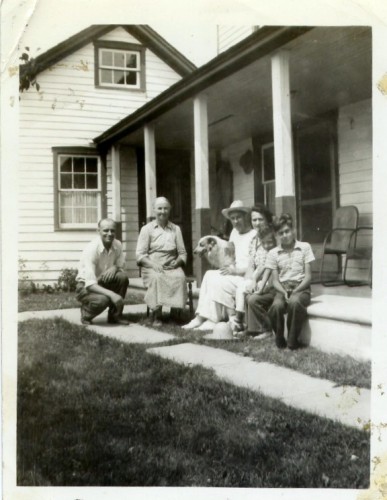
The persons in the photo are Joseph Richter Sr., Mary Keglovits Tanzos (wife of Louis),
Walter Hulsen, Mary Richter Hulsen, Joseph Hulsen, Walter "Sonny" Hulsen.
A gathering of Burgenländers at the Ignatz Tanczos farm on a Sunday afternoon (c. 1937).
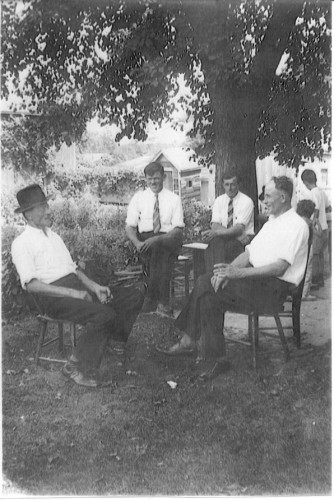
Shown here are Louis Tanzos, Ignatz Tanczos, John Tanzos Sr., Eddie Miksits.
This was a time when you wore your Sunday Best when visiting - notice the
white shirts and ties.
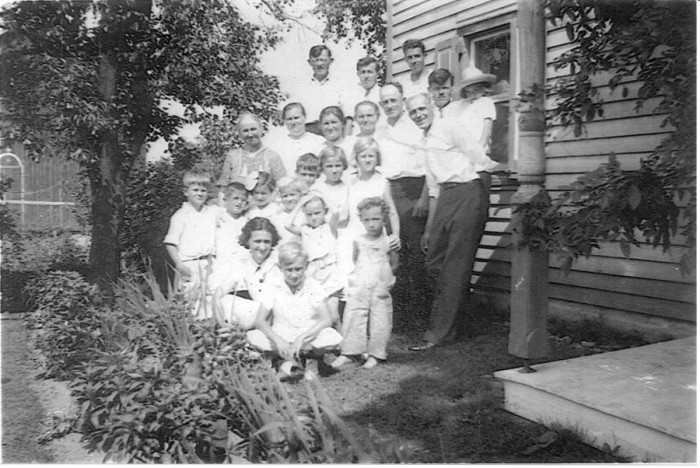
My father, Ignatz Tanczos, is holding a five-year-old me (in hat).
Ah, those were the times! |
| HISTORICAL BB NEWSLETTER ARTICLES
Editor (Tom Steichen): This is part of our monthly series designed to recycle interesting
articles from the BB Newsletters of 10 years ago. This time we recycle an August 1999
Newsletter article contributed by BB member Bob Unger that explains important information
about the 1828 Hungarian census. Enjoy!
THE BURGENLAND BUNCH NEWS No.62B AUGUST 15, 1999 |
| 2) HUNGARIAN CENSUS OF 1828 (by Bob Unger)
The Hungarian census of 1828 is an excellent snapshot in time, which proves not only the
existence of a family at a particular period, but also gives information about assets and
other items of genealogical value. Information about this census has been reported previously
in Burgenland Bunch newsletters #2 and #54. However, recent developments warrant an update.
The Hungarian Census of 1828 includes eight rolls of LDS microfilm (nos. 0623007-0623014; see
the LDS catalog under Hungary, Vas County, Census) for Vas Megye (county) and covers 615
towns, villages or pusztas (manorial work stations). The place names are listed in an
alphabetic sequence by Hungarian name (occasionally a German or Croatian name) with each
assigned a number. You must know the Hungarian name (pre 1921) of your village. Use the index
to locate each village's number and fast forward the film to that number. The header page
shows the following with the village name and number hand written: "UNGARISCHES STAATSARCHIVE,
ARCHIVUM PALATINALE, LANDSKONSKRIPTION 1828, HUNGARIA, COMITATUS CASTRIFERRIE." Vas Megye
(county) derived from the Latin "comitatus (county) Castriferrei".
While doing research for this article I once again was awe struck by how fortunate we are that
Gerry Berghold had the inspiration to form the Burgenland Bunch (BB), and to have so many
dedicated volunteers who contribute to its growing success. So I think it appropriate to
report first on how the BB helped with this effort. First it made me aware that the Hungarian
census of 1828 existed and that it contained information that would reveal significant details
about the lives and time of my Unger ancestors. Next, by saving each BB newsletter on my
computer hard drive, I had an easy search of all that had been reported by the BB on that
specific topic. The search revealed sufficient details so that I was able to go directly to
sources naming persons who had previously researched that census, namely Mrs. Martha Conner,
residing at 7754 Pacemont Ct., Las Vegas, NV 89147-5122.
I subsequently corresponded with Mrs. Conner, gaining more insight into this very dedicated
person who freely shares the results of her genealogical efforts with others. She is also a
very humble person. BB newsletters #2, and 54 stated that she was the expert concerning the
Hungarian census of 1828. To this accolade she wrote:
"Please set this thought straight -- I am not an expert on the 1828 Hungarian Land Census. I
am a plodding housewife -- no expert or genius. The books were needed -- no one had time to do
it -- it challenged me-- the spelling of the names are not perfect but as I read them --
anyone can do this. A HOBBY that stimulates the brain cells to making them work instead of
being lazy!!! It is also fun to help others."
Mrs. Conner has so far translated 13 counties: 1. Bacchus Bodrog; 2. Baranya; 3. Torontl; 4
Tolna; 5. Temes; 6. Fejr; 7. Szatmar; 8. Komrom; 9. Gyor; 10. Moson; 11. Szerm; 12. Krass, and
14. Arad. While Vas County is not yet translated, she has had the Latin census headings
translated by a professional service bureau. The translated counties' census records are
available (1999) for $25 per county plus $3.00 for handling and postage for census books
numbers 1, 2, 4, 6, 7, 11. Books number 3 and 5 are $35.00 + $3.00 for handling and postage;
books number 8, 9 and 10 are available for a total cost of $25.00, and book numbers 12 & 14
are available for $30.00 + $3.00 for handling and postage. In addition, Mrs. Connor offers a
book of cities, book # 13, containing all the cities named in the 1828 Hungarian Land Census
microfilms of the LDS Library - 52 counties, available for the total cost of $15.00. (In a
recent letter from Mrs. Conner, she commented that she really worked hard on book #13, and now
considers it one of her best books.) Book # 15, Csanad, Csongrad, & Bekes (made into one book)
will be ready late in 1999. Each of the books contains only the extraction of names from this
census record and no other information. It is important to add that the books do not relate
the old Hungarian village names to their subsequent and currently used names.
I asked Mrs. Connor about her plans for doing a book on the Vas County 1828 Hungarian Land
Census. She responded by saying that she has already started her next book, which will be on
Maramaros and Ugocsa counties. Hopefully, because of the Burgenland Bunch's interest in Vas
County, she will put it high on her priority list. She stated that her ultimate goal is to
donate her books to the LDS Library in Salt Lake and thereby have them on microfilm
so that everyone can read them anywhere.
Mrs. Connor and her husband create these books as a retirement hobby, wishing to help as many
people as possible. She jokingly adds: "So glad to be doing this instead of spending time at
the casinos or watching TV. We are 73 years old and think that this keeps us out of mischief
plus being productive." Thus, it is not considered a big business. They make 15 copies at a
time to replenish their stock and the cost essentially reflects charges for photocopying. She
said that she makes the books from beginning to end with help from her husband, Bob, on the
computer. The members of the Burgenland Bunch, wish to thank Mrs. Connor for her great
contribution in helping others with their individual genealogical research. It is truly
through such efforts that we can now better understand and appreciate our ancestors.
CENSUS HEADINGS
Used with Mrs. Connor's permission, the following are translated Latin to English column
headings for the 1828 Hungarian Land Census.
No. 1 Names of providers of information
No. 2 Providers of information of either sex that are married or unmarried but deemed to be
married through the decree of 18?0 up to the age of 60 years, inclusive.
No. 3 These include: Professionals, Citizens, Farmers, Tenants, Subtenants, Brothers, Sons,
Daughters, Slaves, Servants, Workers, Merchants, Magistrates
No. 4 Houses in which the census is taken
No. 5 Urban lands, Urban fields, Market price of fields
No. 6 Grain production; Which contributors farm the land and hold it under civil law; Profit
attained by the contributors, assuming one harvest. How many harvests after one planting? What
is the normal price of one planting?
No. 7 Meadows; Meadows, held under civil law. Harvest; Profit attained by the contributors,
assuming a single planting
No. 8 Vines; Amount of harvest; Profit attained. Assuming one grape harvest; Pickers required;
Average number of urns per picker; Average current price obtained per picker
No. 9 Apple and plum orchards; Harvest; Attained profit, assuming one single extended harvest
No. 10 Large domestic animals: Oxen; Heifer and milk cows; Sterile cows; Steers and cows, over
3 years old; Steers and cows, over 2 years old; Draft and riding horses, over 3 years old;
Draft and riding horses, over 2 years old
No. 11 Small domestic animals; Sheep one year old and above; Swine one year old and above;
Goats one year old and above
No. 12 Forest; Which occupy arable land; Weight of annual nut yield and amount of lumber
No. 13 Signature
No. 14 Notes
Translator's Note: We cannot guarantee the accuracy of this translation for the following
reasons: 1. This copy was typed in Latin from the original, and there are several
typographical errors and misspellings. 2.We do not know the origin of the Latin document. The
Latin language differed from country to country; in Italy, Latin was different from that used
in Germany and other places. However, we have translated the document to the best of our
ability and hope you are satisfied. (end of census headings)
With the help of Mrs. Connor's 1828 Hungarian Census heading translations I was able to
uncover the following information about Rudersdorf, the village of my Unger ancestors, which
is now part of the Bezirk/District of Jennersdorf, Burgenland, Austria - formerly Vas County,
Hungary. I share this information as a means of showing the type of information that can be
uncovered about your ancestor's village with a little effort on your part, and thereby gain
better insight into their conditions during that period of time.
The following is a 1828 snapshot of Rudersdorf, Austria. It documents that the village had 336
individuals recorded as married or unmarried but deemed to be married through a decree, and
that there were 7 separate Unger families residing in Rudersdorf in 1828;
Household # # Married Occupation Land Meadows Oxen Cows Horses (Not house #)
Persons area (?)
#29 Janos Unger 3 Farmer 12 3 2 1 0
#52 Janos Unger 4 Farmer 12 3 2 1 0
#53 Milhaly Unger 3 Farmer 12 3 0 0 2
#62 Adam Unger 3 Farmer 12 3 0 1 2
#80 Milhaly Unger 2 Tenant 0 0 0 0 0
#83 Janos Unger 4 Tenant 0 0 0 0 0
#109 Janos H. Unger 1 Tenant 0 0 0 0 0
(ED. Note: given the proclivity of naming sons after the father, I'd suggest (guess) #80, 83 &
109 were sons of #53, 29 & 52, working as married tenants on someone else's property until
such time as they inherited)
Unfortunately the census does not list the ages of the individuals, nor their house numbers.
Thus, since there were four different Jnos Unger families listed, there is no way of knowing
how any of them fit into our Unger family tree. But, we know for certain that there were 7
separate Unger families in Rudersdorf in 1828.
A summary of other information about 1828 Rudersdorf follows:
Number of married individuals 336
Number of houses 114
Number of farmers 74
Number of tenants 40
Number of subtenants 3
Number of brothers 5
Number of sons 43
Number of daughters 24
Number of slaves (?) 16
Number of servants 18
Number of workers 3
Number of merchants 0
Number of magistrates 1
Number of oxen 104
Number of milk cows 89
Number of sterile cows 26
Number of steers and cows over 2 yr 19
Number of horses over 3 years 50
Number of pigs 85
From the above it appears that Rudersdorf, one of 613 villages or cities in Vas county in
1828, had a very orderly structure. It indicated that everyone apparently shared the same
living standards, because each family unit had essentially the same assets. As is the case
with most genealogical research results, the answer to one question often prompts other
questions. Thus I offer the following questions for BB members to ponder.
1. What person or government agency created the structure for the villages of Vas County?
2. With very few exceptions, it appears that each family unit was allocated the same amount of
land. How was this administered? Was it a first come and claim process, as was the case during
the free land rush here in the USA, or were specific areas first mapped and then allocated to
specific family units?
3. Who were the administrators of the village? How were they selected?
Anna Kresh noted that the article in BB newsletter #60 entitled 1839 Hungarian Tax Records did
make any reference to house numbers and asked why.
Neither the 1828 Hungarian Land Census or the 1839 Hungarian tax record for VAS County makes
any reference to house numbers. Based on my research thus far, it appears that the use of
house numbers first appeared in 1844 records. I subsequently learned that the house numbers
were originally assigned in sequence as each new house was built. Years later the houses were
re-numbered, using a numbering sequence according to the house location on a specific street,
much like that currently done in the USA. During recent visits to Rudersdorf I found that many
old houses display both the old and the new house numbers.
It is interesting that in the left hand edge of the 1839 Hungarian tax records, each entry was
numbered in sequence, starting with 1 and, in the case of Rudersdorf, continued through entry
152. I compared those entry numbers with those found on the 1828 Hungarian Census records and
found the same reference numbers being used. There were 7 Ungers listed in the 1828 census and
9 listed in the 1839 tax records. However, most of the numbers matched, i.e. entry # 29 was
for Janos Unger in the 1828 Census, and entry # 29 was also for Janos Unger in the 1839 tax
record. Thus it appears that each family was assigned a specific reference number. Possibly
they used that referencing system, then later starting using house numbers in 1844, where I
first found them in church records. |
| END OF NEWSLETTER
NOTICE (Terms and Conditions): The Burgenland Bunch (BB) was formed and exists to
assist Burgenland descendants in their research into their heritage and, toward that end,
reserves the right to use any communication you have with us (email, letter, phone
conversation, etc.) as part of our information exchange and educational research efforts.
• If you do not want your communication to be used for this purpose, indicate that it is
"confidential" and we will abide by that request.
• Correspondents who communicate with the BB without requesting confidentiality retain their
copyright but give a non-exclusive license to the BB allowing us to forward to BB members,
publish in our monthly newsletter or on our website, and/or subsequently and permanently
archive all or parts of such communications.
The Burgenland Bunch homepage (website) can be found at:
http://www.the-burgenland-bunch.org/
Use our website to access our lists and web pages.
BB NEWSLETTER ARCHIVES (reached via Home Page hyperlinks)
Burgenland Bunch Newsletter (c) 2009 by The Burgenland Bunch
All rights reserved. Permission to copy excerpts granted if credit is provided. |

 After
reading newsletter 189, Hannes Graf and I had several emails back and forth, he asked how was
the Burgenland Bunch doing in the St. Louis, Missouri area. My response was that I had nothing
to report; if it was alive and well, I had no knowledge of that. Well, Hannes challenged me,
and asked what could I do to get it off of life support. As a result, we found that
approximately 70 members were located in the area where I live. An email was sent indicating
that we were attempting to get the members together. Of course, a problem with email addresses
is, that many are outdated and they came back undeliverable. However, about 20 members did
respond favorably, and some are still trickling in.
After
reading newsletter 189, Hannes Graf and I had several emails back and forth, he asked how was
the Burgenland Bunch doing in the St. Louis, Missouri area. My response was that I had nothing
to report; if it was alive and well, I had no knowledge of that. Well, Hannes challenged me,
and asked what could I do to get it off of life support. As a result, we found that
approximately 70 members were located in the area where I live. An email was sent indicating
that we were attempting to get the members together. Of course, a problem with email addresses
is, that many are outdated and they came back undeliverable. However, about 20 members did
respond favorably, and some are still trickling in. Here
is the list of attendees:
Here
is the list of attendees: In March,
I had the most wonderful trip to Burgenland. Before departing the states, a good German friend
of mine advised me that I would not be able to go to the church in Welgersdorf for a birth
record; in small towns, they commonly share a priest. My friend advised me to go to
Großpetersdorf. Luckily for me I had asked her to write a letter in German describing what I
was looking for. When I arrived in Großpetersdorf, the woman at the local church only spoke a
little English and the letter proved helpful. She sent me on to another town (I can't recall
the name). In this town[,] no one was at the church. I stood around wondering what to do. Then
a nice couple came out from their home and offered help. They then called a woman employed by
the church by the name of Amy Wagner. Amy advised the couple to send us over to her and she
would take us to the records. We then followed Amy to another town (I think it was
Hannersdorf). She opened a glorious cabinet filled with books holding records. What a sight to
see all these old fabulous books with people's histories inside! We took a photo of my
grandfather's record. Amy then went out of her way to guide us to Welgersdorf. She wanted to
make sure we found it.
In March,
I had the most wonderful trip to Burgenland. Before departing the states, a good German friend
of mine advised me that I would not be able to go to the church in Welgersdorf for a birth
record; in small towns, they commonly share a priest. My friend advised me to go to
Großpetersdorf. Luckily for me I had asked her to write a letter in German describing what I
was looking for. When I arrived in Großpetersdorf, the woman at the local church only spoke a
little English and the letter proved helpful. She sent me on to another town (I can't recall
the name). In this town[,] no one was at the church. I stood around wondering what to do. Then
a nice couple came out from their home and offered help. They then called a woman employed by
the church by the name of Amy Wagner. Amy advised the couple to send us over to her and she
would take us to the records. We then followed Amy to another town (I think it was
Hannersdorf). She opened a glorious cabinet filled with books holding records. What a sight to
see all these old fabulous books with people's histories inside! We took a photo of my
grandfather's record. Amy then went out of her way to guide us to Welgersdorf. She wanted to
make sure we found it. From the moment when I
have to check in, a different world begins. I was never on a flight, so also I was never in
the USA or outside of Europe. All was new for me, and I had not slept the night before. At
11.05 the flight started from Vienna and ended at 14.00 (+6 hours) in NY-JFK. When we got out
of the plane, we arrived to the customs area, where nearly 1000 people were waiting. I was
thinking , "Oh my god, it will take 3 hours to go out of the airport; I hope Frank will wait
for me." It took really 2,5 hours to come out and meet Frank and Elsie Paukowits who were
waiting for "Santa Claus". I was very tired and so we have no sightseeing this day. Also when
I start in Vienna, there has been about 19° C low humidity, but in Queens it had about 38° C
and a full humidity. So I had troubles to breathe and I immediately got a cold from the
differences between real and air-conditioned temperature. I also was not able to sleep the
first night for more than 2-3 hours.
From the moment when I
have to check in, a different world begins. I was never on a flight, so also I was never in
the USA or outside of Europe. All was new for me, and I had not slept the night before. At
11.05 the flight started from Vienna and ended at 14.00 (+6 hours) in NY-JFK. When we got out
of the plane, we arrived to the customs area, where nearly 1000 people were waiting. I was
thinking , "Oh my god, it will take 3 hours to go out of the airport; I hope Frank will wait
for me." It took really 2,5 hours to come out and meet Frank and Elsie Paukowits who were
waiting for "Santa Claus". I was very tired and so we have no sightseeing this day. Also when
I start in Vienna, there has been about 19° C low humidity, but in Queens it had about 38° C
and a full humidity. So I had troubles to breathe and I immediately got a cold from the
differences between real and air-conditioned temperature. I also was not able to sleep the
first night for more than 2-3 hours. The first sightseeing
trip to lower Manhattan, after a curious breakfast. Frank, Elsie and I go by LIRR and subway
to the southern-most point. When I came out to the streets, I was so overwhelmed about the
buildings and so many people around. Also I was the only person in Manhattan who had a jacket
on. This made everybody know that I was a tourist. I know that I will make a similar trip as
my Lehner and Schreyer relatives made it 1904. They started in Ellis Island and ended up in
South Bend.
The first sightseeing
trip to lower Manhattan, after a curious breakfast. Frank, Elsie and I go by LIRR and subway
to the southern-most point. When I came out to the streets, I was so overwhelmed about the
buildings and so many people around. Also I was the only person in Manhattan who had a jacket
on. This made everybody know that I was a tourist. I know that I will make a similar trip as
my Lehner and Schreyer relatives made it 1904. They started in Ellis Island and ended up in
South Bend.
 But
after looking to the Ellis-Island and Liberty-Island over the water, I decide to don't want to
go there, because it was too much for me. We had to wait some hours for getting tickets
because it was the end of school and there were many people. So I will see it when I come
again and there is a reason to come back. After a walk into the streets around Ground Zero, we
went to the East River, where we had a longer rest. My favorite points are water (sea, lakes,
river) and bridges, so it was a nice point under the Brooklyn Bridge. At the evening, we drove
back, to see Manhattan at night; it was really amazing, with all the lights on the streets and
bridges.
But
after looking to the Ellis-Island and Liberty-Island over the water, I decide to don't want to
go there, because it was too much for me. We had to wait some hours for getting tickets
because it was the end of school and there were many people. So I will see it when I come
again and there is a reason to come back. After a walk into the streets around Ground Zero, we
went to the East River, where we had a longer rest. My favorite points are water (sea, lakes,
river) and bridges, so it was a nice point under the Brooklyn Bridge. At the evening, we drove
back, to see Manhattan at night; it was really amazing, with all the lights on the streets and
bridges. I
cannot sleep well again, maybe for 4 hours. This day we had breakfast at "Dunkin' Donuts"; I
always wondered about that, because I understand it as "drunken donuts," so I was not sure
about the illumination scale after the breakfast. But there I meet some of the friends of
Frank and Elsie, nice mix of people. We went to the NY Transportation Museum in Brooklyn; it
was very interesting to me, because I am a fan of all transport systems. In the afternoon we
had a trip to Long Beach and at the evening. I met their family, and grandson Kenny. (see
NL-182)
I
cannot sleep well again, maybe for 4 hours. This day we had breakfast at "Dunkin' Donuts"; I
always wondered about that, because I understand it as "drunken donuts," so I was not sure
about the illumination scale after the breakfast. But there I meet some of the friends of
Frank and Elsie, nice mix of people. We went to the NY Transportation Museum in Brooklyn; it
was very interesting to me, because I am a fan of all transport systems. In the afternoon we
had a trip to Long Beach and at the evening. I met their family, and grandson Kenny. (see
NL-182) Attending
at the Stiftungsfest of the Coplay Sängerbund, I meet many people, whose names I now forget;
sorry. I had so many meetings, I never remember who told me what. I made some pics of the
Coplay cemetery with many Burgenländer names on the gravestones. Also, I attended the concert
of the best Hianzn choir I ever heard in my life, with the famous bandleader Bobby Strauch. At
Emma's dessert-kitchen, we had a good ending of the meeting days and I was taken to my next
hosts, Rudy and Anna Kresh.
Attending
at the Stiftungsfest of the Coplay Sängerbund, I meet many people, whose names I now forget;
sorry. I had so many meetings, I never remember who told me what. I made some pics of the
Coplay cemetery with many Burgenländer names on the gravestones. Also, I attended the concert
of the best Hianzn choir I ever heard in my life, with the famous bandleader Bobby Strauch. At
Emma's dessert-kitchen, we had a good ending of the meeting days and I was taken to my next
hosts, Rudy and Anna Kresh. This
day was the hardest, I think, for all of us three. We started to look of all the remembering
places, I saw their first apartment, where the first child was born, some schools, colleges,
where also Gerry Berghold has been, and Frank Teklits, if I'm correct. Then we drove to
Amishland, looking for the horse-wagons and farm workers like Burgenland 150 years ago. The
next stop was at the Pennsylvanian Railroad Museum at Strasburg, nearby Lancaster. There we
look around for some hours before starting to the next point. We cross the Susquehanna to York
and Gettysburg. After attending the show at the Museum we drove around the historic area and I
made a walk at the "Little Round Top", to overview the scenery. This day ended at the Kresh
Lane in Butler after nearly 19 hours! We were really nearly dead!
This
day was the hardest, I think, for all of us three. We started to look of all the remembering
places, I saw their first apartment, where the first child was born, some schools, colleges,
where also Gerry Berghold has been, and Frank Teklits, if I'm correct. Then we drove to
Amishland, looking for the horse-wagons and farm workers like Burgenland 150 years ago. The
next stop was at the Pennsylvanian Railroad Museum at Strasburg, nearby Lancaster. There we
look around for some hours before starting to the next point. We cross the Susquehanna to York
and Gettysburg. After attending the show at the Museum we drove around the historic area and I
made a walk at the "Little Round Top", to overview the scenery. This day ended at the Kresh
Lane in Butler after nearly 19 hours! We were really nearly dead! From this day on, I was
acclimatized; I could breathe better and I slept well for the first time. Also, it was the
not-air-conditioned border of America. We drove around the landscape and to Pittsburgh, where
Anna shows me the Austrian Room at the Cathedral of Learning. We took Anna's grandson with us
and he liked to do everything with the adults.
From this day on, I was
acclimatized; I could breathe better and I slept well for the first time. Also, it was the
not-air-conditioned border of America. We drove around the landscape and to Pittsburgh, where
Anna shows me the Austrian Room at the Cathedral of Learning. We took Anna's grandson with us
and he liked to do everything with the adults. We
meet at Indianapolis at the area, where Emily Hayden was living, before she went to Harvard as
teacher. It is beside the medical centers and I think it was a canal or a creek before, but in
between it's nice to walk around. I did not know it, but in the days when I was in NY,
something happened what changed very much. Heidi, the 22 years old daughter of Gary Schreyer
died by diabetes complications. So that half of the family was very sad and didn't attend some
planned meetings. I understood the situation and at the afternoon we rode to Logansport for a
"say good bye" ceremony.
We
meet at Indianapolis at the area, where Emily Hayden was living, before she went to Harvard as
teacher. It is beside the medical centers and I think it was a canal or a creek before, but in
between it's nice to walk around. I did not know it, but in the days when I was in NY,
something happened what changed very much. Heidi, the 22 years old daughter of Gary Schreyer
died by diabetes complications. So that half of the family was very sad and didn't attend some
planned meetings. I understood the situation and at the afternoon we rode to Logansport for a
"say good bye" ceremony. At the last evening,
I was very daring to accept a flight with cousin Mike Hayden in his Mooney airplane. But this
I will never forget, a flight around the Indianapolis area and looking down, seeing all the
farmland and buildings. Mike is a real good pilot since 38 years. The second highlight should
be the 4th of July party, but it rains hard, so the Indianapolis downtown fireworks was
cancelled. Mike has an apartment on the 19th floor with full sight of downtown. But I met some
new family members and children there.
At the last evening,
I was very daring to accept a flight with cousin Mike Hayden in his Mooney airplane. But this
I will never forget, a flight around the Indianapolis area and looking down, seeing all the
farmland and buildings. Mike is a real good pilot since 38 years. The second highlight should
be the 4th of July party, but it rains hard, so the Indianapolis downtown fireworks was
cancelled. Mike has an apartment on the 19th floor with full sight of downtown. But I met some
new family members and children there. All
together, we started in the morning for a trip to South Bend, where the Lehner and Schreyer
families had settled. They show me the house where the grandparents are living, the train
crossing where Andrew Schreyer in 1927 found his end (NL-130), the houses where the parents
are living, schools, the Notre Dame University, the cemeteries, the area where the Lehner-farm
was located (today, it is the Lehner-court of Granger with Lehner-street) and so on. A Freeway
crosses the farmland and most of the area is housing developments. At last we had a gathering
of all relatives at the home of John & Judy Lehner beside the Notre Dame University area. Paul
M. Lehner, III invited also some BB-Members so we had a little "BB-Indiana-picnic". At the
evening we drove to the apartment of Joanne and Mike Hayden in Culver at Lake Maxinkuckee to
stay over night.
All
together, we started in the morning for a trip to South Bend, where the Lehner and Schreyer
families had settled. They show me the house where the grandparents are living, the train
crossing where Andrew Schreyer in 1927 found his end (NL-130), the houses where the parents
are living, schools, the Notre Dame University, the cemeteries, the area where the Lehner-farm
was located (today, it is the Lehner-court of Granger with Lehner-street) and so on. A Freeway
crosses the farmland and most of the area is housing developments. At last we had a gathering
of all relatives at the home of John & Judy Lehner beside the Notre Dame University area. Paul
M. Lehner, III invited also some BB-Members so we had a little "BB-Indiana-picnic". At the
evening we drove to the apartment of Joanne and Mike Hayden in Culver at Lake Maxinkuckee to
stay over night. We
changed our program, because at 5th of July, Mike talks with Evelyn Lehner about the farm and
some rememberings. So we drove again to South Bend to meet her, because she is 98 years old.
We had a good day at her home, beside the old farmhouse which still exists. She shows me a
picture of an unknown woman, but it was my grandmother! After the meeting, we had a short trip
to the Michigan lake for a little evening walk.
We
changed our program, because at 5th of July, Mike talks with Evelyn Lehner about the farm and
some rememberings. So we drove again to South Bend to meet her, because she is 98 years old.
We had a good day at her home, beside the old farmhouse which still exists. She shows me a
picture of an unknown woman, but it was my grandmother! After the meeting, we had a short trip
to the Michigan lake for a little evening walk. The
Göttweig monastery's traditional records of the year 1158 mention a "Gotscalcus de
Landeshere." The first castle was erected probably somewhat earlier to protect an important
road. The Landsees were ministers of the Earls of Pitten and presumably kinsman of the
Stubenberger family from Styria. The castle became possession of the Hungarian Crown already
in 1222. It was the western outpost of the county of Lutzmannsburg and part of the line of
castles which was to protect the western border of Hungary. King Béla IV passed it to his
cupbearer Conrad who, however, changed fronts and became a follower of the Bohemian king
Przemysl Ottokar II. Therefore, in 1263, Landsee was handed over to his Steward and Gespan (a
medieval chieftain in the west and south Slavic region) of Ödenburg, Laurentius Aba, whose
successors were followers of the earls of Güssing. And so Landsee was one of the castles that
were conquered by Duke Albrecht in course of the feud of Güssing in 1289.
The
Göttweig monastery's traditional records of the year 1158 mention a "Gotscalcus de
Landeshere." The first castle was erected probably somewhat earlier to protect an important
road. The Landsees were ministers of the Earls of Pitten and presumably kinsman of the
Stubenberger family from Styria. The castle became possession of the Hungarian Crown already
in 1222. It was the western outpost of the county of Lutzmannsburg and part of the line of
castles which was to protect the western border of Hungary. King Béla IV passed it to his
cupbearer Conrad who, however, changed fronts and became a follower of the Bohemian king
Przemysl Ottokar II. Therefore, in 1263, Landsee was handed over to his Steward and Gespan (a
medieval chieftain in the west and south Slavic region) of Ödenburg, Laurentius Aba, whose
successors were followers of the earls of Güssing. And so Landsee was one of the castles that
were conquered by Duke Albrecht in course of the feud of Güssing in 1289. But following the
peace of Hainburg the command over the castle was restored to the king of Hungary. Then the
Athinais of the family of the Aba were in possession of Landsee but at the end of the 14th
century it passed to the Earls of Mattersdorf-Forchtenstein. Wilhelm of Forchtenstein, the
last of his family, pawned his properties to the Habsburger Albrecht VI, who bought Landsee in
1447 and passed it on to his brother, Emperor Friedrich III. In 1459, the dominion fell into
the hands of the Hungarian king Matthias Corvinus. In 1482 he endowed with the dominion Ulrich
von Grafeneck, who, however, is recorded as owner already for the year 1475. It was him who
ordered the late Gothic styled upgrading of the stronghold. In 1506 Ulrich von Weisspriach,
who also was Lord of Kobersdorf, became fief-holder in Landsee. His possessions were located
around Ödenburg (Sopron) which constantly led to conflicts. In the following "Landsee-feud,"
his widow hired several groups of mercenaries, including the bandit leader Franz Magutsch, to
harass the city. Finally the bandits were caught and Gertrud von Weisspriach died in jail in
1523.
But following the
peace of Hainburg the command over the castle was restored to the king of Hungary. Then the
Athinais of the family of the Aba were in possession of Landsee but at the end of the 14th
century it passed to the Earls of Mattersdorf-Forchtenstein. Wilhelm of Forchtenstein, the
last of his family, pawned his properties to the Habsburger Albrecht VI, who bought Landsee in
1447 and passed it on to his brother, Emperor Friedrich III. In 1459, the dominion fell into
the hands of the Hungarian king Matthias Corvinus. In 1482 he endowed with the dominion Ulrich
von Grafeneck, who, however, is recorded as owner already for the year 1475. It was him who
ordered the late Gothic styled upgrading of the stronghold. In 1506 Ulrich von Weisspriach,
who also was Lord of Kobersdorf, became fief-holder in Landsee. His possessions were located
around Ödenburg (Sopron) which constantly led to conflicts. In the following "Landsee-feud,"
his widow hired several groups of mercenaries, including the bandit leader Franz Magutsch, to
harass the city. Finally the bandits were caught and Gertrud von Weisspriach died in jail in
1523. In 1548 her son Hans
handed Landsee to his brother-in-law, the imperial councilor and Gespan Erasmus Teufel. But
Teufel was caught and executed in Istanbul by the Turkish and the archbishop of Gran
(Esztergom), Nikolaus Oláh, bought the dominion of Landsee. In 1561 he handed it over to his
nephew Nikolaus Császár, whose son-in-law started the extension of the castle to a mighty
fortress shortly before 1600. When his daughter Ursula married Nikolaus Esterházy in 1612,
Landsee became the possession of the family, still owning it today.
In 1548 her son Hans
handed Landsee to his brother-in-law, the imperial councilor and Gespan Erasmus Teufel. But
Teufel was caught and executed in Istanbul by the Turkish and the archbishop of Gran
(Esztergom), Nikolaus Oláh, bought the dominion of Landsee. In 1561 he handed it over to his
nephew Nikolaus Császár, whose son-in-law started the extension of the castle to a mighty
fortress shortly before 1600. When his daughter Ursula married Nikolaus Esterházy in 1612,
Landsee became the possession of the family, still owning it today. Landsee
is one of the biggest castle ruins in Europe. It lies on a dominant location above the
Stooberbach valley. The actual stronghold is surrounded by four circular fortification walls.
The outer wall is 1700 meters long and fortified by ten small bastions. For the protection of
the first gate, which states the date of 1668, serves a two-story bastion containing a
guardroom. Crossing a bridge lying on piles you reach the second gate above which there is a
broad machicoulis. Originally, a drawbridge used to be in front of it. The gate structure
reaches far into the moat, so that it was possible to take the second defensive wall (a high
earth wall bearing a palisade) under fire from there. This wall was erected around 1600 to
protect the third wall from direct artillery fire. Its gate is protected by a tower and
guardroom as well. The following approximately 20 meters-broad moat is spanned by another
wooden bridge. In front of the next gate was a counterpoise bridge. It was decorated by the
coat of arms of the Weisspriach family.
Landsee
is one of the biggest castle ruins in Europe. It lies on a dominant location above the
Stooberbach valley. The actual stronghold is surrounded by four circular fortification walls.
The outer wall is 1700 meters long and fortified by ten small bastions. For the protection of
the first gate, which states the date of 1668, serves a two-story bastion containing a
guardroom. Crossing a bridge lying on piles you reach the second gate above which there is a
broad machicoulis. Originally, a drawbridge used to be in front of it. The gate structure
reaches far into the moat, so that it was possible to take the second defensive wall (a high
earth wall bearing a palisade) under fire from there. This wall was erected around 1600 to
protect the third wall from direct artillery fire. Its gate is protected by a tower and
guardroom as well. The following approximately 20 meters-broad moat is spanned by another
wooden bridge. In front of the next gate was a counterpoise bridge. It was decorated by the
coat of arms of the Weisspriach family. From
a small bailey and via wooden corridors and stairways you could once get into the several
rooms. Still today they show relics of Gothic door and window carpeting, fireplaces and
arches. The Romanic donjon forms the core of the stronghold and was built on the highest point
of the quartzite rock. Later its mainly attacked side in the West was fortified and reached
its today's wall thickness of more than 10 meters. The tower is crowned by a characteristic
wall arch, the relic of a former cupola.
From
a small bailey and via wooden corridors and stairways you could once get into the several
rooms. Still today they show relics of Gothic door and window carpeting, fireplaces and
arches. The Romanic donjon forms the core of the stronghold and was built on the highest point
of the quartzite rock. Later its mainly attacked side in the West was fortified and reached
its today's wall thickness of more than 10 meters. The tower is crowned by a characteristic
wall arch, the relic of a former cupola.

